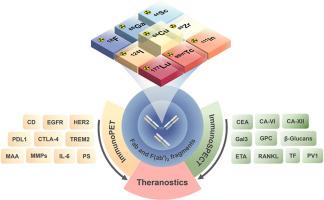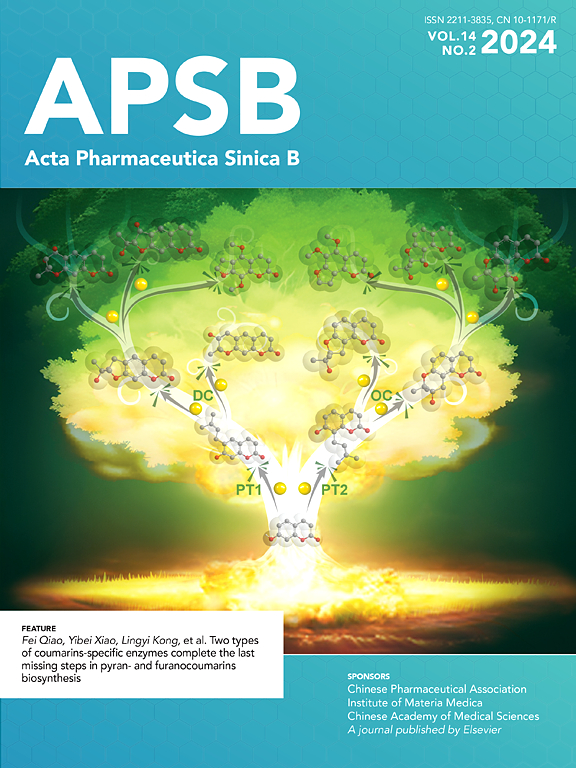Advances in immunoPET/SPECT imaging: The role of Fab and F(ab′)2 fragments in theranostics
IF 14.6
1区 医学
Q1 PHARMACOLOGY & PHARMACY
引用次数: 0
Abstract
With the advent of precision medicine and personalized treatment, targeted therapies have become pivotal in oncology. Noninvasive molecular imaging, especially immunoPET/SPECT, plays a crucial role in refining cancer diagnostics and treatment monitoring by visualizing biological processes at the molecular level. This review explores the dynamic field of immunoPET/SPECT imaging using Fab and F(ab′)2 fragments, characterized by advantageous pharmacokinetics and swift clearance from the bloodstream, making them suitable for same-day imaging procedures. We examine contemporary strategies for radiolabeling these fragments with PET and SPECT radionuclides and discuss potential advancements and the challenges anticipated in the further development of Fab and F(ab′)2 fragments. Despite the complexities involved in their development, these fragments hold significant promise for advanceing personalized cancer treatment. Keys to this advancement are innovative radiolabeling techniques, site-specific conjugation chemistries, and short-lived radionuclides, all of which are crucial for overcoming existing limitations and enhancing the clinical utility of these imaging agents. As research progresses, Fab and F(ab′)2 fragments are expected to become central to the future of cancer diagnostics and therapeutic monitoring, thereby improving patient management and contributing significantly to the evolution of personalized medicine.

免疫pet /SPECT成像的进展:Fab和F(ab ')2片段在治疗中的作用
随着精准医疗和个性化治疗的出现,靶向治疗已成为肿瘤治疗的关键。无创分子成像,特别是免疫pet /SPECT,通过在分子水平上可视化生物过程,在改进癌症诊断和治疗监测中起着至关重要的作用。本综述探讨了使用Fab和F(ab’)2片段的免疫pet /SPECT成像的动态领域,其特点是具有有利的药代动力学和快速从血液中清除,使其适合于当日成像程序。我们研究了用PET和SPECT放射性核素对这些片段进行放射性标记的当代策略,并讨论了Fab和F(ab’)2片段进一步发展的潜在进展和预期的挑战。尽管它们的发展过程很复杂,但这些片段在推进个性化癌症治疗方面有着重要的前景。这一进步的关键是创新的放射性标记技术、位点特异性偶联化学和短寿命放射性核素,所有这些都是克服现有限制和增强这些显像剂临床应用的关键。随着研究的进展,Fab和F(ab’)2片段有望成为未来癌症诊断和治疗监测的核心,从而改善患者管理,并为个性化医疗的发展做出重大贡献。
本文章由计算机程序翻译,如有差异,请以英文原文为准。
求助全文
约1分钟内获得全文
求助全文
来源期刊

Acta Pharmaceutica Sinica. B
Pharmacology, Toxicology and Pharmaceutics-General Pharmacology, Toxicology and Pharmaceutics
CiteScore
22.40
自引率
5.50%
发文量
1051
审稿时长
19 weeks
期刊介绍:
The Journal of the Institute of Materia Medica, Chinese Academy of Medical Sciences, and the Chinese Pharmaceutical Association oversees the peer review process for Acta Pharmaceutica Sinica. B (APSB).
Published monthly in English, APSB is dedicated to disseminating significant original research articles, rapid communications, and high-quality reviews that highlight recent advances across various pharmaceutical sciences domains. These encompass pharmacology, pharmaceutics, medicinal chemistry, natural products, pharmacognosy, pharmaceutical analysis, and pharmacokinetics.
A part of the Acta Pharmaceutica Sinica series, established in 1953 and indexed in prominent databases like Chemical Abstracts, Index Medicus, SciFinder Scholar, Biological Abstracts, International Pharmaceutical Abstracts, Cambridge Scientific Abstracts, and Current Bibliography on Science and Technology, APSB is sponsored by the Institute of Materia Medica, Chinese Academy of Medical Sciences, and the Chinese Pharmaceutical Association. Its production and hosting are facilitated by Elsevier B.V. This collaborative effort ensures APSB's commitment to delivering valuable contributions to the pharmaceutical sciences community.
 求助内容:
求助内容: 应助结果提醒方式:
应助结果提醒方式:


